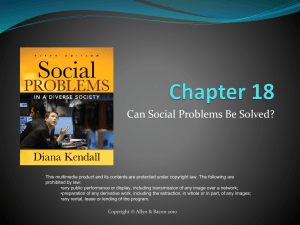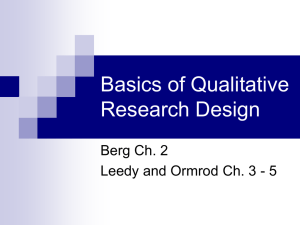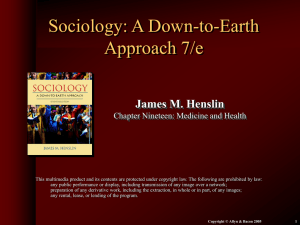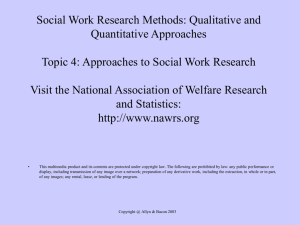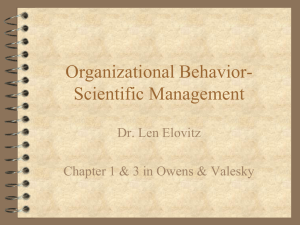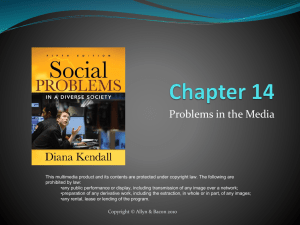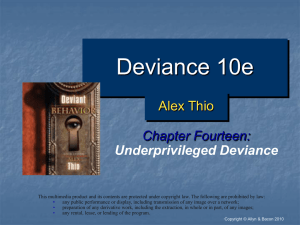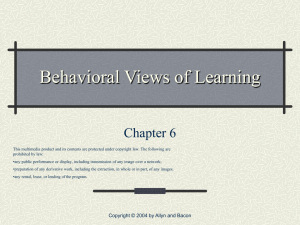Chapter 12
advertisement
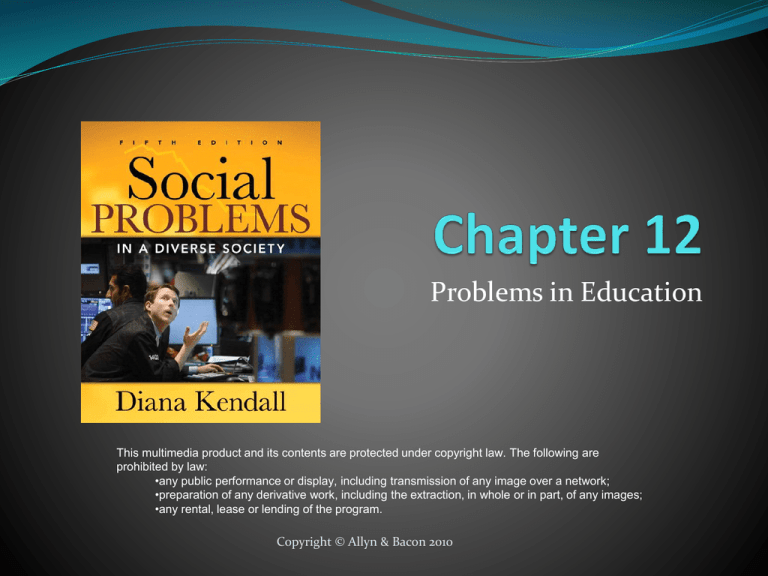
Problems in Education This multimedia product and its contents are protected under copyright law. The following are prohibited by law: •any public performance or display, including transmission of any image over a network; •preparation of any derivative work, including the extraction, in whole or in part, of any images; •any rental, lease or lending of the program. Copyright © Allyn & Bacon 2010 Chapter Outline Perspectives Problems • Functionalist • Conflict • Interactionist • • • • Illiteracy Immigration and Diversity Race, Class, Gender Violence Higher Education • Cost of college education • Affirmative Action Solutions • Functionalist/Conservative • Conflict/Liberal Copyright © Allyn & Bacon 2010 Sociological Perspectives Education: the social institution responsible for transmitting knowledge, skills, and cultural values ina formally organized structure. Functionalist Perspective: Education contributes to smooth functioning in society Provides opportunity for personal fulfillment Provides opportunity for upward mobility Copyright © Allyn & Bacon 2010 Sociological Perspectives, cont. Manifest functions of educ. Latent functions of educ. Socialization Keeps kids off streets Transmission of Keeps young people out of the job market for a few years Culture Social Control Serves a matchmaking Social Placement purpose Change and Innovation Establishes social networks Copyright © Allyn & Bacon 2010 Sociological Perspectives, cont. Conflict Perspective: Schools perpetuate inequalities based on class, race, and gender Students possess different levels of cultural capital Low-income children come to school with different competencies in language and culture A hidden curriculum teaches students to be obedient and patriotic, perpetuating the status quo Tracking teaches different skills Copyright © Allyn & Bacon 2010 Sociological Perspectives, cont. Symbolic Interactionist: Focus on the affects of labeling and classroom Interaction Standardized testing and IQ tests lead to labeling Self-fulfilling prophecy Children see themselves based on the unsubstantiated beliefs and predictions of others Herrnstein’s and Murray’s (1994) The Bell Curve Argued intelligence is purely genetic and some groups (Asians) are inherently “smarter” than others (African Americans) Labels such as “learning-disabled” and “gifted” greatly affect one’s academic experience Copyright © Allyn & Bacon 2010 Problems in Education Functional Illiteracy: Unable to read and/or write at the skill level necessary for carrying out everyday tasks. 1 of 4 adults in this category Much worse for minorities than whites. U.S. companies spend $60 billion per year to educate workers who are functionally illiterate Not just a problem for immigrants but also for native born Americans. Copyright © Allyn & Bacon 2010 Immigration and Diversity Most immigrants have limited formal education and few job skills, they rely on education to educate their children. 20% of U.S. residents over age 5 speak a language other than English at home. Some Asian groups send their children to “cram schools” to help them be more successful. Transitional programs for newcomers have been fairly successful for helping integrate immigrants. Copyright © Allyn & Bacon 2010 Copyright © Allyn & Bacon 2010 Race, Class, Gender and Education Brown v. The Board of Education of Topeka, Kansas (1954) legally desegregated schools, but today schools remain somewhat segregated Schools with high percentages of minorities tend to have: High teacher-student ratios Less qualified teachers Lower expectations of students High dropout rates Latino/a students face educational obstacles Little opportunity to attend preschool Few Latino/a teachers as role models Fewer than 10% of public school teachers are Latino/a High dropout rates Tracking (assigning students to specific courses) recreates segregation in the class room. Copyright © Allyn & Bacon 2010 Copyright © Allyn & Bacon 2010 Race, Class, Gender, and Education, cont. Boys and girls treated differently in school. Studies find teachers pay less attention to girls. Teachers encourage boys to be problem solvers more by asking them more complicated questions. Activities are geared toward boys who are “more boisterous” Girls are starting to make up ground by enrolling in more advanced courses, but much work to do still. Copyright © Allyn & Bacon 2010 School Violence School violence is actually down since the 1990’s To reduce violence many schools use metal detectors and require students to wear uniforms. Teachers often are victims of school violence as well. New technology has helped deter some school violence but won’t fix everything. Copyright © Allyn & Bacon 2010 School Financing Most educational funds come from state appropriations and local property taxes Tax base in city centers is eroding, disadvantaging schools Many schools are overcrowded and need major repairs Solutions: One proposed solution is a Voucher system, whereby families can “buy” education at their school of choice Cut spending on administration and non-instructional activities. Copyright © Allyn & Bacon 2010 Copyright © Allyn & Bacon 2010 Problems in Higher Education Cost to obtain a college education has risen significantly, many students must go into debt to get a degree. Affirmative action Taking race, gender, and ethnicity into consideration for admissions, financial aid, scholarships, and faculty hiring Minority enrollments have dropped in many schools that have eliminated affirmative action US Supreme Court (2003) ruled that race can be a factor for universities in shaping admission programs Copyright © Allyn & Bacon 2010 Solutions Functionalist/Conservative: Greater emphasis on teaching students the basics to prepare them with job skills needed. Work on reducing dysfunctions (school violence, illiteracy) Conflict/Liberal: Major restructuring must occur in education to reduce inequality. Interactionist: Reduce incidence of labeling , help students develop self confidence needed to have greater achievement. Copyright © Allyn & Bacon 2010



